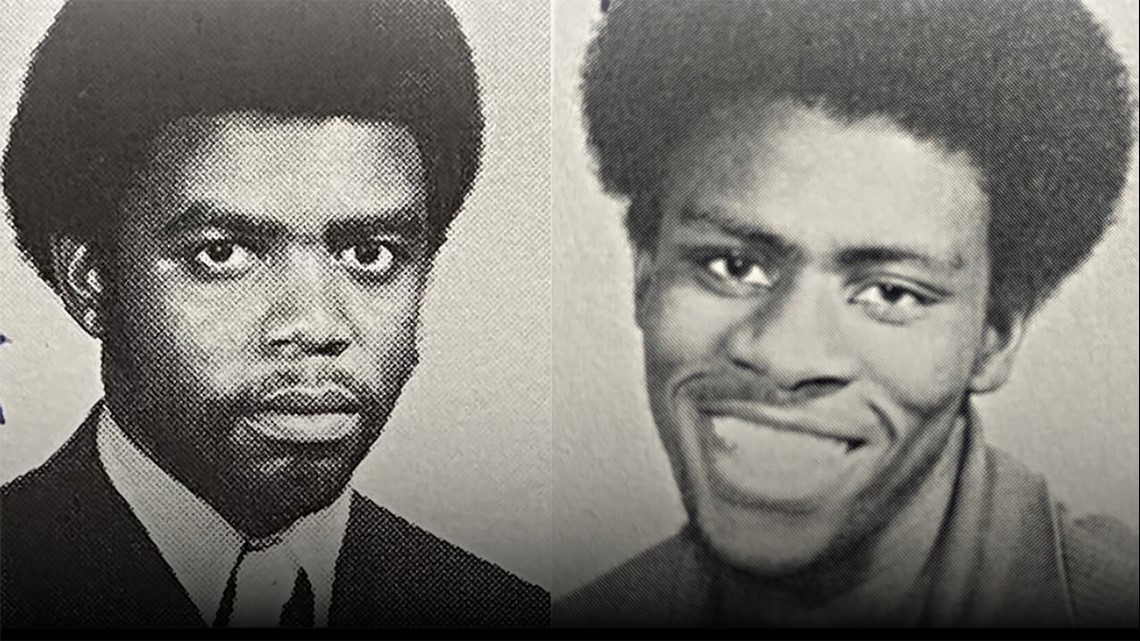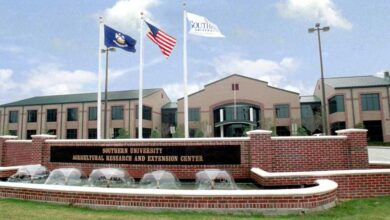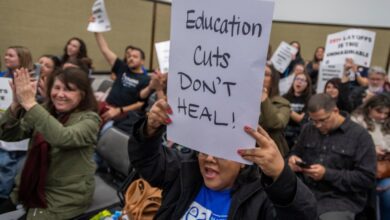For two families, a Southern education meant everything. Then came tragedy.

Josephine and Denver Smith took different approaches to protests at Southern University in the fall of 1972. Josephine skipped class for meetings, while her older brother stayed away and warned her to be careful.
The pair had grown up with 10 other siblings in a tiny sharecropper’s house near New Roads, Louisiana, where they picked cotton in the hot sun and harvested pecans to help make ends meet. When they were not working, they fished, swam by the river levee and, not having paper, scratched their multiplication tables in the dirt with sticks, the oldest checking the work of the youngest.
Despite their modest finances, one thing was always certain: They would go to college.
One by one, the siblings enrolled at Southern University in Baton Rouge. Denver was the third to go, followed by Josephine the next year. And while Josephine lived in a dorm amid the growing campus ferment, Denver – 5 feet, 9 inches and slim – walked each morning to a white-framed Catholic church, where he hopped on a school bus for the hour-long journey southeast to Baton Rouge.
The protests at Southern in October and November 1972 echoed what was happening around the United States in an era of civil rights and anti-war activism. Southern—the main campus in a university system that had the largest number of Black students in the country—had its own history of activism that began with lunch counter sit-ins. By 1972, many of its 9,000 students in Baton Rouge were tired of what they saw as poor funding and teaching, dilapidated buildings and a lack of responsiveness to their concerns.
From those frustrations came weeks of protests, class boycotts and demands for a change in the school’s leadership. Rather than sticking with negotiations, university officials repeatedly summoned sheriff’s deputies and state troopers onto campus—and a standoff between roughly 150 students and 85 heavily armed officers that Nov. 16 ended in tragedy.
Amid the chaos and tear gas, a single blast of buckshot fired by a deputy from the East Baton Rouge Parish Sheriff’s Office killed two 20-year-old men in a stream of fleeing students.
One was Denver Smith, who may have just wandered into the crowd to make sure Josephine was safe. The other was Leonard Douglas Brown, a junior who had finished breakfast with his girlfriend and went out to see why the crowd had gathered.
Neither man had been involved in the protests, and it was never determined which deputy fired the shot.
Now, as the 50th anniversary of the shooting approaches, a 10-month examination by the LSU Cold Case Project provides a much clearer picture of one of the most troubling episodes in race relations in Baton Rouge—and one that still resonates nationally amid the tense relations between police officers and young Black men.
This series is based on dozens of interviews with family members of the victims; student leaders and witnesses; and former sheriff’s deputies, FBI agents and prosecutors who had never discussed the case publicly.
Researchers from LSU’s Manship School and the Southern University Law Center also studied nearly 2,700 pages of FBI documents that reveal how agents quickly narrowed their search to a handful of deputies but could not prove who fired the fatal shot.
A gubernatorial commission created shortly after the shooting determined there was “no justification” for it and that the confrontation “should never have happened.” The commission, headed by William J. Guste, who was then Louisiana’s attorney general, found no evidence that any of the students was armed.
It also concluded that Southern officials were not prepared to cope with student unrest, criticized protesters for disrupting classes in the weeks leading up to Nov. 16 and chastised law enforcement officials for responding with more force than was needed.
“No one should have pointed a gun at those students,” Mike Barnett, who was at Southern that day as a young sheriff’s deputy and is now a liaison to the Louisiana Sheriff’s Association, said in a recent interview.
“There was no threat from them or anyone else at the time the shot went off,” he said.
Challenging the ‘Old Guard’
In the spring of 1972, a group of Southern students drove to a national Black political convention in Gary, Indiana. Among them were Fred Prejean and his girlfriend, Ola Sims.
Prejean was a tall, talkative 25-year-old political science major who had returned to his education after years in community activism. At 17, he had been inspired hearing the Rev. Martin Luther King Jr. speak at the March on Washington. He also was struck by how casually people of different races intermingled in the march’s crowds.
Sims was a 19-year-old psychology major who grew up in north Louisiana near Grambling State University, another historically Black institution. She had accepted a scholarship to Southern for a program in the psychology department, wanting to experience something new.
The conference in Gary, aimed at electing more Black people to office, sparked a new connection to politics in Sims—one that took hold of her that fall when a young professor, Charles Waddell, resigned as chairman of Southern’s psychology department.
Waddell was beloved by his students—and was everything they did not see in Southern President George Leon Netterville Jr., a quiet 66-year-old with white hair and dark-framed glasses.
Waddell was frustrated by a lack of equipment for his research. He took his concerns to Netterville, who had started as Southern’s business manager in 1932 before being promoted to its vice president for finance and becoming Southern’s third president in 1968.
Netterville promised things would improve. But in meeting after meeting, they did not, and on Tuesday, Oct. 17, Waddell informed his students he was leaving.
Around midnight, a group of students braved the dark to protest outside Netterville’s home, and he came out briefly to try to calm them.
But to the students, Sims said, a consensus was forming that Netterville was basically an “old guard” administrator who followed “old-guard rules” – and they were going to have to keep pushing if they were going to see any change.
Tensions rising on both sides
Sims brought Prejean to a meeting organized by the psychology students, who soon realized that students in other departments shared their concerns.
Students noted that LSU’s main campus in Baton Rouge spent $2,325 per student, while Southern spent only $1,327 per student, and that their school was losing faculty to better pay elsewhere.
“The conditions on the campus overall were not comparable or even close to the conditions that existed at LSU,” Sukari Hardnett, one of the protest leaders, said recently. “And it wasn’t fair.”
As student talk bubbled, a loose organization formed.
The group, called Students United, argued that Southern was failing to serve the Black community. Members put together a long list of grievances, ranging from substandard housing and pest problems to no emphasis on the Black experience anywhere in the curriculum.
They thought that part of the solution might be a council system that would allow faculty and students voting power over university decisions, and they wanted Netterville to resign.
The students delivered the grievances to Netterville on Oct. 23, and at an assembly the next day in the Men’s Gymnasium, he agreed to some student involvement in university oversight. But the meeting fell apart when it became clear that he did not intend to step down, and the tactics escalated on both sides.
Worried about how the students might react, Netterville had arranged for 100 sheriff’s deputies to be on standby at the Baton Rouge airport. Black sheriff’s deputies in plain clothes walked around campus watching for any signs of trouble.
Shortly after the meeting ended, an estimated 1,000 students descended on the state Board of Education and the Capitol, with some marching the seven miles from campus and others driving.
Gov. Edwin Edwards, a Democrat who had taken office eight months earlier with Black support, stepped outside to meet them. Edwards refused to consider Netterville’s resignation. But he told the students he would negotiate on other issues if they returned to school.
The next day, Oct. 24, protest leaders met in the Southern gym. They decided to call for a boycott of classes, giving speeches outside the dorms to rouse support.
‘You got to be careful’
The surge in activism caught the attention of Josephine Smith, a 19-year-old education sophomore, who was concerned by Southern’s lack of a Black studies program.
“I had never been in a group or organization that was so big – bigger than me – as far as a cause,” Josephine recalled recently. “And I felt led to join that cause for a good reason.”
Denver did not share his sister’s feelings, mirroring concerns from some students that the protests would interrupt their education.
A junior studying computer science more than a decade before the internet, Denver preferred to keep his head in his studies and encouraged Josephine to do the same. He often stopped by her dorm to check on her and her suitemates.
“You got to be careful,” Denver told her.
Denver had almost left Southern after receiving a job offer from a technology company in Houston. But he had declined it that summer after his mother suggested he finish his education.
Leonard Brown, a 5-foot-10-inch vocational agriculture education major known as Doug, also was focused on his studies, and he returned home to Gilbert in northeast Louisiana for two weeks to avoid the protests.
Brown had loved living on a farm as a child. He attended Southern with the help of an educational opportunity grant and joined the National Society of Pershing Rifles, a military honor society that focused on developing leadership skills.
Brown also had an infant daughter, who lived with his mother, and he went home every weekend to visit them. His sister Evelyn Turner said he hoped to get married and start a farm after graduating.
Negotiate or confront with force?
As the protests churned forward through late October, the students stuck to their demands that Netterville leave and for a say in running the school—and Gov. Edwards and Netterville would not give in on those points.
The men’s gym became the center of student organizing as well as student-led classes and tutoring.
It was exhausting, said Sims, who married Prejean in 1974. In an interview in her Lafayette home, she recalled that amid the boycotts and late nights, her normally high GPA dropped. She left class quickly one day, embarrassed, after realizing she had been so busy she had forgotten to wash her clothes.
When students gathered in the gym on Tuesday, Oct. 31, a school official told them that the meeting was unauthorized. They headed over to the administration building, where Netterville refused to meet them. Instead, he called in the sheriff’s deputies and canceled classes until Monday, Nov. 6.
It is not clear how much say Netterville, who died in 2000, had at this point, with Edwards and an all-white state education board heavily involved. But judging from how two other historically Black universities had handled similar situations, there seemed to be a choice between further negotiation and the risks involved in relying on law enforcement to quell the protests.
At Howard University in Washington, D.C., in 1968, administrators negotiated as 1,000 students occupied the administration building for four days. The school refused to fire its president, but the protests ended peacefully after it agreed to incorporate Black history and culture into its curriculum and give students input in its disciplinary process.
But in Jackson, Mississippi, in 1970, police killed two protesters at Jackson State. The students were fed up with whites driving through campus shouting racial slurs and throwing bottles, and the students were throwing rocks at the cars.
Any hopes for a compromise at Southern evaporated on Nov. 1, 1972, when 150 students at Southern’s campus in New Orleans occupied its administration building and demanded the resignation of their president, who left eight days later.
Students at Grambling also made demands on Nov. 1, and the next day, roughly 150 of them barricaded the street outside its administration building with chairs and tables from the dining hall and threw rocks through dorm windows.
These incidents –as well as a shootout on North Boulevard earlier that year that had left two Baton Rouge police officers and two Black Muslims dead –also had unnerved many whites and placed law-enforcement officers on edge.
Several Southern protest leaders said in interviews that they cautioned students not to take control of buildings.
“Whenever we had a demonstration and law enforcement came on campus, we urged the students to go back to their dorms, leave the campus, do not engage the police, do not allow them to engage you,” said Herget Harris, an electronics technology major and Students United leader.
When school reopened on Nov. 6, Brown’s mother asked if it was safe to return. His sister said he replied that it must be, since classes were resuming.
About 500 students met in the men’s gym around 10 a.m. that day, and the leaders urged them to keep boycotting classes. State Police and sheriff’s deputies sealed off campus but had no confrontations with students. They left after half the crowd returned to class.
Students United slammed the university at a press conference for bringing police onto campus, and members of the physics department condemned the “senseless” choice.
‘Expect trouble tomorrow’
Over the next several days, a mysterious fire broke out at Southern’s Horticulture Barn, and some students protested on the field during a football game. Harris said Students United did not condone these activities, but Netterville asked for arrest warrants to be drawn for Harris and seven other student leaders, including Prejean and Hardnett, for disrupting university operations. After some of the students were arrested, Netterville said the remaining warrants would not be executed if the disruptions stopped.
But the boycotts continued, and on Nov. 15, university and law enforcement officials met at the East Baton Rouge Parish Prison to decide whether to execute arrest warrants for the rest of the leaders. According to an FBI interview with Sheriff J. Al Amiss, they discussed “whether this arrest of students would stir up trouble and add to the unrest already existing on the campus.”
Still, they decided to execute the warrants. And that evening, Netterville left a message for Gov. Edwards saying that he expected trouble the next morning.
Drew Hawkins, Maria Pham, Allison Allsop, Alex Tirado, Adrian Dubose, Oliva Varden, Cayli Pham, and Brea Rougeau contributed reporting. This series is supported by the Data-Driven Reporting Project.




